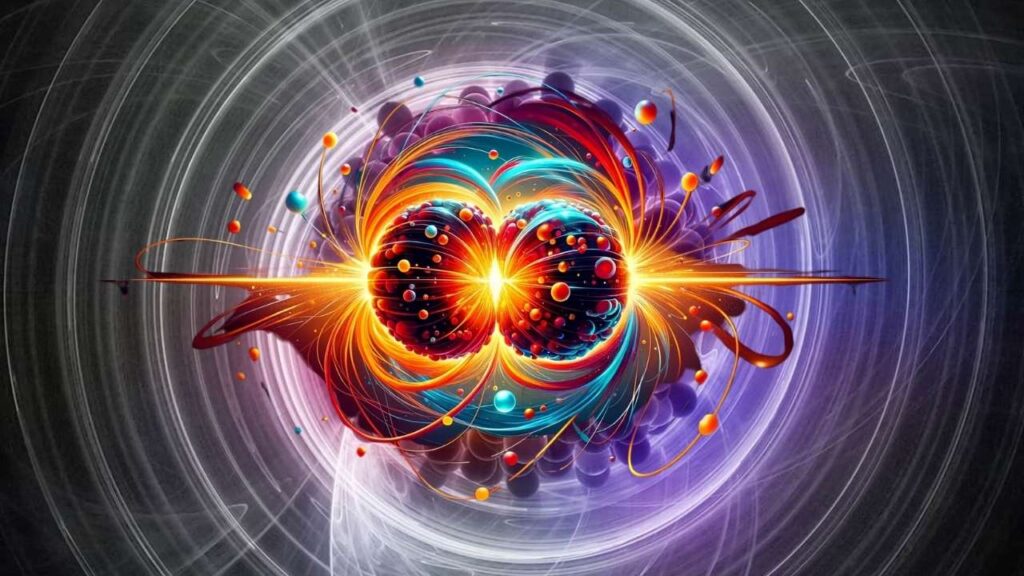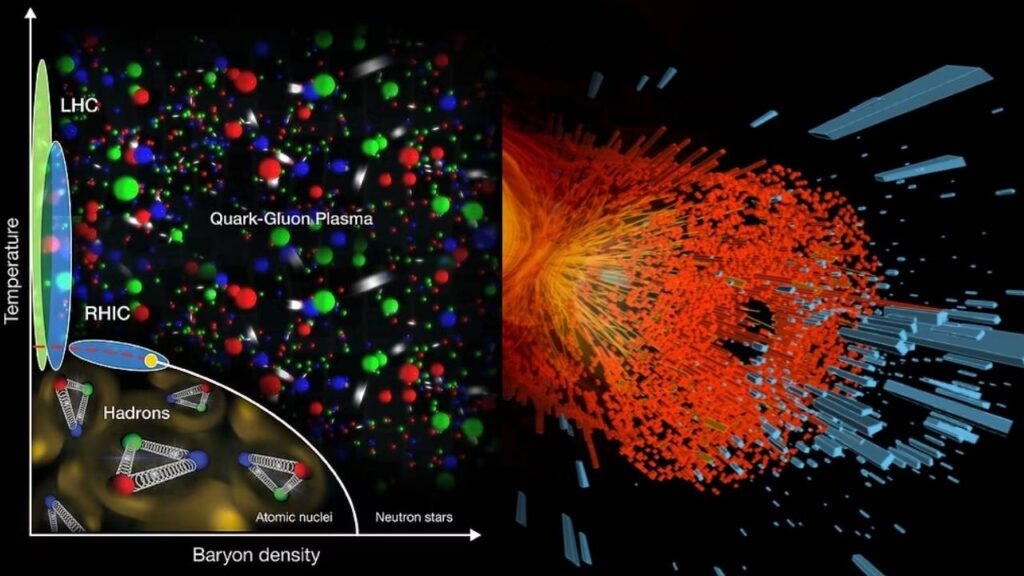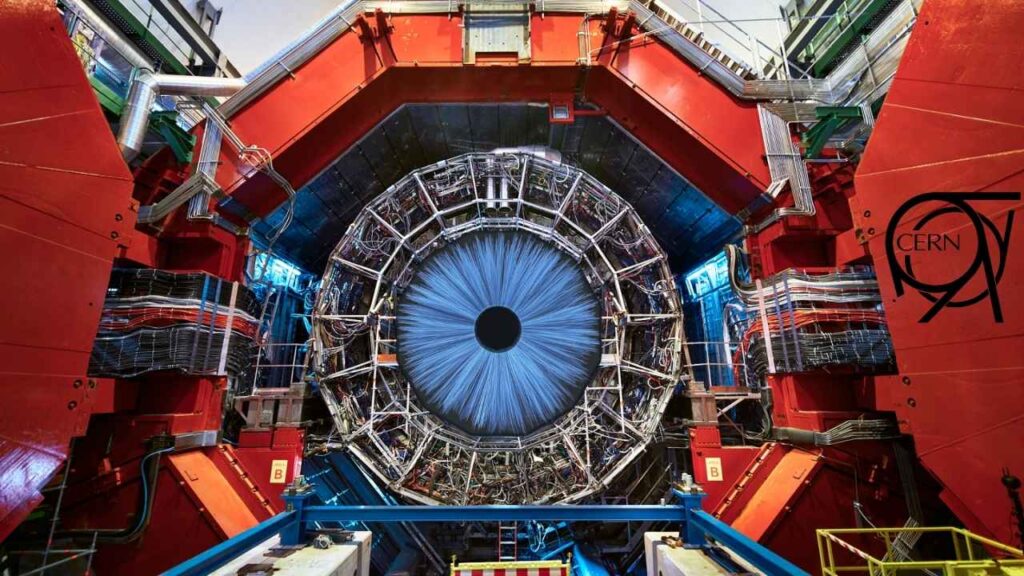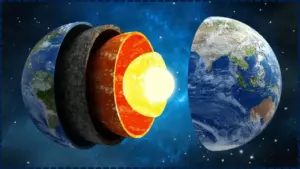Study Measures Thermodynamic Properties of Quark-Gluon Plasma With New Precision: The thermodynamic properties of quark-gluon plasma (QGP)—a form of matter thought to have filled the universe just microseconds after the Big Bang—are now being measured with unprecedented precision. Using a combination of new theoretical frameworks and advanced particle collider data, researchers are uncovering details about how this exotic substance behaves at extreme conditions of temperature and pressure.

In 2024–2025, major studies from CERN’s CMS experiment, the RHIC STAR collaboration, and theoretical teams working with quantum gravity models have converged to deliver remarkably accurate data on QGP’s temperature, entropy, pressure, and even the speed of sound within the plasma. These findings are reshaping our understanding of the universe’s birth and advancing the frontiers of quantum and particle physics.
Table of Contents
Study Measures Thermodynamic Properties of Quark-Gluon Plasma With New Precision
| Feature | Details |
|---|---|
| What is QGP? | A superhot state of matter made of free quarks and gluons |
| Recent Findings | High-precision measurements of QGP thermodynamics and sound velocity |
| Temperature | ~2 to 3.4 trillion Kelvin |
| Speed of Sound | ~0.49c |
| Theoretical Model | Linear-Quadratic Generalized Uncertainty Principle (LQGUP) |
| Experimental Facilities | CERN’s Large Hadron Collider (LHC), RHIC (USA) |
| Career Pathways | High-energy physics, quantum computing, cosmology |
| Official Reference | CERN Home |
The precision measurement of thermodynamic properties in quark-gluon plasma marks a major leap forward in understanding our universe’s earliest moments. From quantum gravity theory to experimental high-energy collisions, this area of research is a melting pot of innovation, collaboration, and scientific discovery.
Whether you’re a curious student, a physicist, or just someone fascinated by how the universe began, these findings offer a new window into matter, energy, and space-time at the most fundamental level.
What Is Quark-Gluon Plasma?
Quark-gluon plasma is not something you’ll find in everyday life. It’s a hot, dense fluid where quarks and gluons—the basic building blocks of matter—roam freely instead of being locked inside protons and neutrons.
This state of matter existed for a fleeting moment after the Big Bang, and scientists now recreate it in powerful particle accelerators by smashing heavy ions (like lead or gold) at nearly the speed of light. The result: a tiny fireball that mirrors the conditions of the early universe.
Why Study Thermodynamic Properties of QGP?

Just like water or air, QGP has thermodynamic properties such as temperature, energy density, and pressure. But in QGP, these exist under extreme quantum conditions, making them key to understanding:
- How the universe cooled and formed particles
- How matter transitions between states at ultra-high energy
- The interplay between quantum mechanics and gravity
With precise measurements, scientists can better test and refine models of quantum chromodynamics (QCD)—the theory describing how quarks and gluons interact.
Experimental Discoveries: Temperature and Sound in the Early Universe
Unbelievable Heat: QGP’s Temperature
In 2024, RHIC’s STAR collaboration used thermal dilepton radiation (electron-positron pairs) to directly measure the temperature of QGP. Their findings suggest it reaches between 2 and 3.4 trillion Kelvin, far hotter than the core of the Sun (15 million Kelvin).
These measurements confirm theoretical predictions made by lattice QCD simulations, supporting decades of research into particle thermodynamics.
QGP’s Sound Barrier: Speed of Sound
The CMS experiment at CERN revealed another remarkable metric—the speed of sound in QGP. It’s about 0.49 times the speed of light, slower than in most regular materials, but expected for such dense, strongly interacting matter.

Understanding this helps scientists model how shock waves and pressure gradients evolve in the QGP, crucial for understanding early-universe expansion and collision simulations.
Theoretical Support: LQGUP and Quantum Gravity
A study published in early 2025 used the Linear-Quadratic Generalized Uncertainty Principle (LQGUP) to recalculate QGP thermodynamics. This principle adjusts Heisenberg’s Uncertainty Principle to include quantum gravity effects, which become important at Planck-scale physics.
Using LQGUP, researchers refined formulas for:
- Entropy density
- Energy-pressure relationships
- Sound speed
- Specific heat capacity
This theoretical upgrade helps unify quantum field theory with elements of string theory and loop quantum gravity, offering a more complete view of QGP behavior at extreme scales.
Historical Background: How QGP Research Evolved
- 1970s: QGP proposed in high-energy physics theories.
- 1990s: Early experiments at CERN and Brookhaven’s RHIC begin.
- 2000s–2010s: LHC and RHIC create reliable QGP signatures.
- 2020s: Shift toward precision measurements and theoretical synthesis with quantum gravity.
This long road reflects the gradual transformation of QGP from a theoretical prediction into a well-characterized physical system.
Role of Lattice QCD Simulations
Lattice QCD provides a numerical method to solve the equations of quantum chromodynamics by placing them on a space-time grid. These simulations allow physicists to predict how QGP should behave under specific conditions.
The temperature range, phase transition behavior, and equation of state of QGP have all been accurately modeled with lattice QCD, offering a benchmark against which real-world experimental data is compared.
Implications for Cosmology and the Big Bang
Understanding QGP helps scientists model what happened within microseconds of the Big Bang, when the universe was a seething soup of particles. Precise measurements allow cosmologists to refine:
- Inflationary models
- Matter-antimatter asymmetry theories
- Dark matter origin hypotheses
With each new QGP data point, we inch closer to explaining why the universe looks the way it does today.
Careers in Quark-Gluon Plasma Research
For those interested in joining this cutting-edge field, here are some pathways:
| Role | Required Background | Potential Employers |
|---|---|---|
| Theoretical Physicist | Ph.D. in Physics, Quantum Field Theory | CERN, Universities |
| Accelerator Engineer | M.Sc./Ph.D. in Engineering Physics | Brookhaven Lab, Fermilab |
| Computational Scientist | Data science, lattice QCD experience | National Labs, HPC centers |
| Science Communicator | Physics + Journalism background | Outreach orgs, science media |
New Geopolymer Tech Transforms Glass and Waste Into Ultra-Durable Green Building Material
AI-Driven Models Accelerate Molecular and Materials Discovery in Biomedical Research
Superconducting Diode Bridge Efficiently Converts AC to DC for Quantum Circuits
FAQs About Study Measures Thermodynamic Properties of Quark-Gluon Plasma With New Precision
What is QGP made of?
QGP is made of quarks and gluons in a deconfined state. These are normally trapped inside protons and neutrons.
How do scientists recreate QGP?
By smashing heavy nuclei (like gold or lead) at nearly the speed of light in colliders like LHC and RHIC.
How is QGP detected?
Using specialized detectors that observe the particles and radiation emitted from high-energy collisions. Measurements focus on jets, dileptons, and thermal signatures.
What’s the significance of speed of sound in QGP?
It helps model shockwave behavior, pressure propagation, and early universe physics.
Is this research purely theoretical?
No. It blends theoretical physics, high-performance computing, and real-world experimentation using billion-dollar particle accelerators.



















